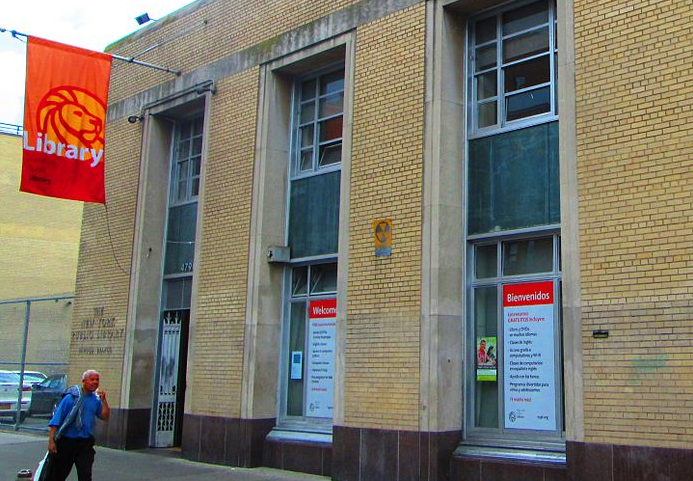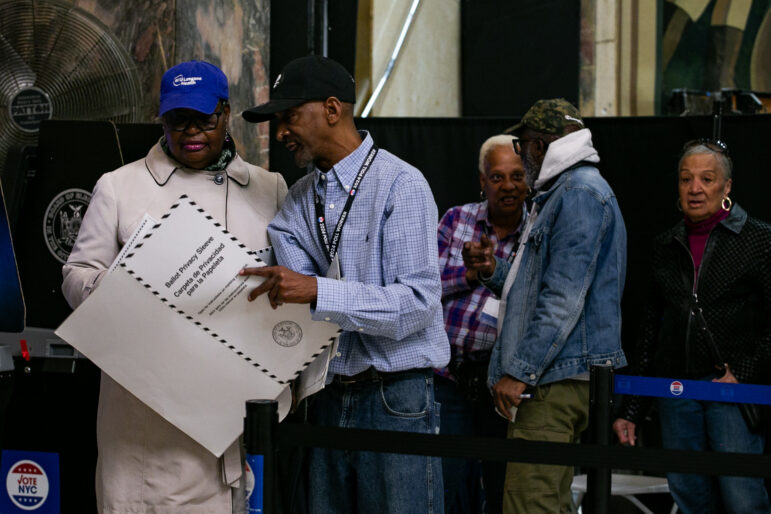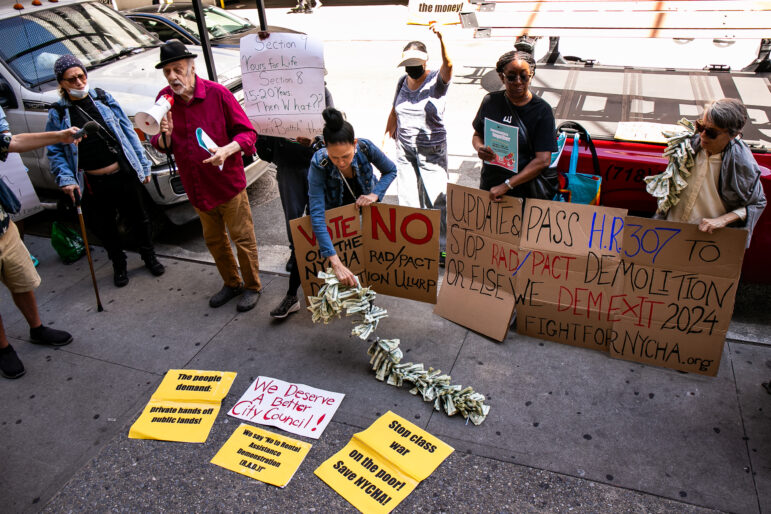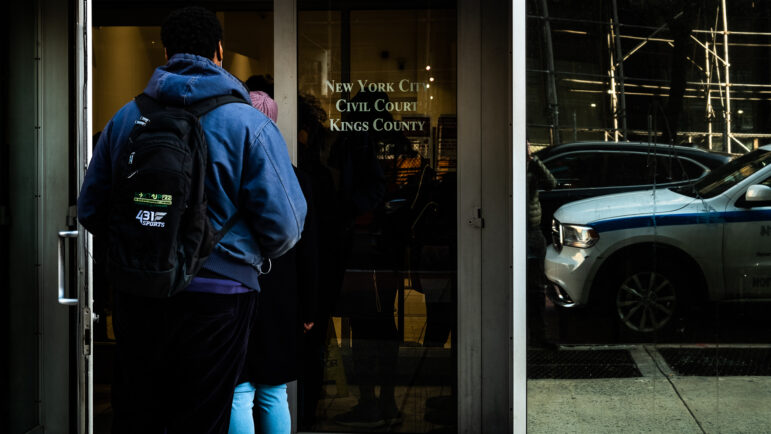
Beyond My Ken
The city says the NYPL Inwood library, which has been renovated before, could use further work.
Almost a year after the city said it was moving quickly to propose a rezoning plan for Inwood, the city has yet to produce a draft scope of work describing the details of the proposal. Some believe the city put the rezoning on the backburner after community residents pushed local Councilmember Ydanis Rodriguez to say no to Sherman Plaza, a privately-initiated mixed-income development project planned for the area that would have used city subsides. The administration expressed displeasure with Rodriguez’s no vote on the project, which some residents said was too tall, and others, not deeply affordable enough.
“Conversations about the Inwood Neighborhood Plan are ongoing as the city has sought to take in extensive community feedback about the best way to move forward,” said Russell Murphy, a spokesperson for Rodriguez in an e-mail to City Limits. “We continue to be very interested in this process and hope that we will arrive at a plan that pleases the many who have weighed in about the needs of Inwood.”
In the meantime, the Department of Housing Preservation and Development (HPD) is working with Rodriguez and the Robin Hood Foundation on another project to bring housing to the area: redeveloping the Inwood public library with 100 percent rent-restricted housing and a renovated library space of the same size. HPD held community visioning sessions for the library in January and say the feedback they received will inform a Request for Proposal (RFP) released for the site later this year. The library, which was built in the 1950s, has been renovated before, but the City says it needs further improvement.
According to DNAInfo, the library project has sparked an argument between Rodriguez and Citizens Defending Libraries, a citywide group that organizes against library redevelopment projects. The group’s founder, Michael White, says that the city’s past library redevelopment projects have benefited the real-estate industry more than library users, and points out that in one case a redeveloped library got smaller, while in another the library was closed for longer than expected.
White says that rather than approaching Inwood residents with a plan to redevelop the library with housing, the city ought to ask Inwood library users what they want and consider alternative proposals, including not redeveloping the library at all, redeveloping a larger library or developing a mixed use library and commercial space.
The Northern Manhattan Is Not For Sale Coalition, which includes local residents as well as citywide groups like Faith in New York and the Metropolitan Council on Housing, is still determining its position. The group agrees that HPD have not created space for sufficient feedback from the local Spanish-speaking community, and they are hosting their own community town hall to solicit more input at Good Shepherd School Auditorium, 620 Isham Street, on Saturday March 18 from 2 to 4 p.m.
So far, members of the group are in agreement that they don’t want the city to sell the land to a private developer, but might be more open to a project if the land was held by a community land trust, a nonprofit entity governed by a board of residents and community members and dedicated to ensuring the structures on the land remain permanently affordable. They’re still debating whether redevelopment would be appropriate and if so, in what shape and form.
The coalition has heard some community members express concerns about the height of a new development and how long the library could be out of service, but others have noted the neighborhood’s need for housing for seniors, homeless families and those making less than 50 percent AMI.
“We need to be building and preserving affordable housing that actually affordable to the community,” said Maya Bhardwaj of Faith In New York, a member of the coalition.
The group organized against the Sherman Plaza development on the grounds that it failed to include enough deeply affordable housing.
The group Inwood Preservation has issued their own list of demands, including that the library land remain city-owned or become part of a community land trust, that a replacement library be provided before the current library is demolished, that preferably the existing building would be “repurposed” rather than “demolished,” and that the new zoning would be similar to what now exists, or at least that a height limit of seven or eight stories would be applied. A survey released by HPD showed the agency was considering building heights from six to as many as seventeen stories, according to DNAInfo.
In an e-mail to City Limits, Rodriguez expressed his interest in using a community land trust at the site.
“At the end of the day, our community desperately needs deeply affordable housing and moving this project forward can have tremendous benefits. I’ll remain vocal about exploring the creation a community land trust, as well as using the adjacent parking lot space and the underutilized space behind the library that has sat dormant for years, which can add to the number of units and provide important community amenities like an indoor sports facility or more,” he said.









6 thoughts on “With Inwood Rezoning Slowed, Attention Turns to Inwood Library Project”
It should not be a 40 story luxury tower. In Brooklyn Heights a 40 story luxury tower with a smaller library is replacing the former library. Inwood deserves better than a smaller library or possibly no library at all.
Facts about zoning and the library redevelopment:
– Inwood has no contextual zoning, despite years of requests from the community board. Inwood has no historic districts either. The only protection of the consistent built form is the uniform zoning — all of Inwood’s residential areas, including the library site, are zoned R7-2.
– Every single building within 1000′ ft of the library site is 6 stories or less.
– 98% of all residential buildings in Inwood, regardless of lot size (some have huge lots) are 8 stories or less.
– The workshops showed photos of 8 buildings as “examples of buildings in Inwood”, 6 of which were from 9 to 21 stories (i.e. from the 2%). Some of those examples were not residential, or had large lot sizes, or were buried into hills at the edge of what would be considered Inwood. The overwhelming context of the 98% of buildings 8 stories or less was not explained or displayed. The word “density” did not appear.
– The survey and workshops both asked residents to “vote” on either a 10, 14 or 17 story redevelopment, stating that a bigger building could hold more apartments.
– For the city to propose anything over 8 or 9 stories would mean rezoning would be required, to a lot density not found north of the GWB and possibly not found north of Central Park.
Those are all facts. Many questions then result:
– Why is the city presuming a rezoning here? The 2014 report “Re-Envisioning New York’s Branch Libraries” which begat the whole libraries-as-housing push listed Inwood as a site for about 57 units (i.e used the existing zoning). To presume to just change zoning at a whim is normally outrageous.
– How would a rezoning of a ~15,000 SF site not be an illegal spot zoning? Because it is for a public use? Because the entire block will be rezoned? Something is wrong here.
– Once residents made an uproar at the workshops about the ignorance of zoning (usually a rather important constraint on any building site), the city added a board that explained the existing zoning would be ok for 70 housing units and a new library in an 8-story building, but that it would be “difficult to finance”. Why?
– Why did BPL get a library redevelopment in Sunset Park that respected and did not try to change the underlying R7A zoning, but Inwood is being pressured to accept a rezoning and massively out of scale building? Somehow that project was financially feasible even at 49 units.
There are games afoot here based on the politics of the moment. Remember that Inwood is also home to Manhattan’s largest and entirely illegal nightclub that operates in open breach of contract on city land and uses entire blocks of city streets for valet parking – also because of games that suited the political situation at the time. Residents are right to be alarmed.
Yeah, and in 1890, Inwood was 99% farmland. If people like you were around then surveying how many 6-story buildings there were in Inwood at the time, you’d be living in a barn now.
Where do you plan to house the 325,000 population increase in our city over the last 5 years if we don’t build a little denser and a little taller in neighborhoods with good transit access? It’s really morally repugnant and regressive to deny others housing because you want to impose some consistent and arbitrary height limit. This is absolutely not morally justifiable.
Always nice to see comments from people who confuse adherence to zoning with some sort of anti-development stance. Maybe do a little reading on the subject before you hit that “enter” key. Or maybe look up “planning”, which happens to exist and is not solely based on cramming in density without any, er, plan. Otherwise why bother with the library – just start filling in the parks. And the rivers. Right?
Inwood has a medium-high zoning that can house thousands and thousands of new apartments without changing the zoning map — there are many underbuilt sites, such as 1-story retail buildings and even vacant lots in areas with R7-2 residential zoning. Those should be built out before ill-thought spot rezonings.
Second, Inwood happens to have vast former industrial tracts that now lie mostly empty. I’m all for parking people and not cars on these lots, and the city started to look at them in the InwoodNYC plan, but because of how poorly that was handled it is now stalled.
PS – zoning was invented in 1917, and was last comprehensively redone in Inwood in the 1960s. You’re welcome to get the city to try and give us a comprehensive contextual zoning overhaul — we’ve tried — but instead all we get are politically-driven spot rezonings. Please learn the difference.
Selling & shrinking New York’s & Brooklyn’s libraries is a bad idea. Libraries need to be properly funded to allow maintenance and capital improvements. Steven A. Schwartzman who hatched the infamous “Central Library Plan”, is now chief of Trump’s business & Economic Advisory Council. This is a trumpish plan. $5million is peanuts, Robin Hood Foundation. Thanks, but no thanks for your venture philanthropy. Build us a replacement library first, bigger and better, before demolishing what we’ve got.
Libraries are the community centers of our times. There must never be a hiatus in their availability. They must never be “downsized”. The only ideas we need to be looking for are those about expanding library functionality. If Robin Hood wants to develop a nearby space with a library of equal or larger size, then when that library is completed, the old one can be torn down.
This rule should be encoded in law.